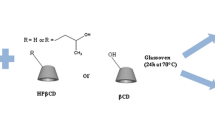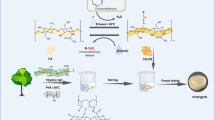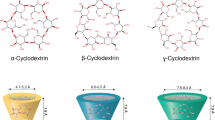Abstract
The present investigation deals with the development and characterization of a new controlled release packaging system for food. Novel sustained system was developed by direct grafting of beta-cyclodextrin (βCD) on the carboxyl groups of TEMPO-oxidized cellulose nanofibers (TEMPO-CNF) in aqueous solution and without using any spacer. Carvacrol, an aromatic essential oil component, was then entrapped in the ensued CD-grafted TEMPO-CNF. Successful functionalization of TEMPO-CNF was confirmed by conductometric titration, Fourier Transform Infrared Spectroscopy, and gravimetric analyses. The βCD-grafted TEMPO-CNF films exhibited sustained release of carvacrol over 150 h before reaching the equilibrium in water. Antimicrobial activity of carvacrol against Bacillus subtilis was increased (or improved by 47 h) from 3 h when using TEMPO-CNF to around (or against) 50 h when using CD-grafted TEMPO-CNF. These promising results pave the way for the development of new bio-based controlled release packaging materials with efficient antibacterial activity.








Similar content being viewed by others
References
Horizon 2020 (2014–2015) Food Security, Sustainable Agriculture and Forestry, Marine, Maritime and Inland Water Research and the Bioeconomy, (commission, E., Ed.)
Han J (2000) Antimicrobial food packaging. Food Technol 54:56–65
Nobile M, Conte A (2013) Bio-based packaging materials for controlled release of active compounds, in packaging for food preservation. Springer, New York
Spaic M, Small DP, Cook JR, Wan W (2014) Characterization of anionic and cationic functionalized bacterial cellulose nanofibres for controlled release applications. Cellulose 21:1529–1540
Lavoine N, Desloges I, Sillard C, Bras J (2014) Controlled release and long-term antibacterial activity of chlorhexidine digluconate through the nanoporous network of microfibrillated cellulose. Cellulose 21:4429–4442
Liu K, Chen L, Huang L, Ni Y, Sun B (2015) Enhancing antibacterium and strength of cellulosic paper by coating triclosan-loaded nanofibrillated cellulose (NFC). Carbohydr Polym 117:996–1001
Marques HMC (2010) A review on cyclodextrin encapsulation of essential oils and volatiles. Flavour Fragrance J. 25:313–326
Zhai F, Li D, Zhang C, Wang X, Li R (2008) Synthesis and characterization of polyoxometalates loaded starch nanocomplex and its antitumoral activity. Eur J Med Chem 43:1911–1917
Bober P, Liu J, Mikkonen KS, Ihalainen P, Pesonen M, Plumed-Ferrer C, von Wright A, Lindfors T, Xu C, Latonen R-M (2014) Biocomposites of nanofibrillated cellulose, polypyrrole, and silver nanoparticles with electroconductive and antimicrobial properties. Biomacromolecules 15:3655–3663
Ferrocino I, Greppi A, La Storia A, Rantsiou K, Ercolini D, Cocolin L (2016) Impact of nisin-activated packaging on microbiota of beef burgers during storage. Appl Environ Microbiol 82:549–559
Jebel SF, Almasi H (2016) Morphological, physical, antimicrobial and release properties of ZnO nanoparticles-loaded bacterial cellulose films. Carbohydr Polym 149:8–19
Auxier JA, Schilke KF, McGuire J (2014) Activity retention after nisin entrapment in a polyethylene oxide brush layer. J Food Prot 6:1624–1629
Gao C, Yan T, Du J, He F, Luo H, Wan Y (2014) Introduction of broad spectrum antibacterial properties to bacterial cellulose nanofibers via immobilising ε-polylysine nanocoatings. Food Hydrocolloids 36:204–2011
Abdulkhani A, Hosseinzadeh J, Ashori A, Esmaeeli H (2015) Evaluation of the antibacterial activity of cellulose nanofibers/polylactic acid composites coated with ethanolic extract of propolis. Polym Compos
Mascheroni EG, Guillard V, Gastaldi E, Gontard N, Chalier P (2011) Anti-microbial effectiveness of relative humidity-controlled carvacrol release from wheat gluten/montmorillonite coated papers. Food Control 22:1582–1591
Johansson C, Bras J, Mondragon I, Nechita P, Plackett D, Simon P, Svetec DG, Virtanen S, Baschetti MG, Breen C, Clegg F, Aucejo S (2012) Renewable fibers and bio-based materials for packaging applications–a review of recent developments. BioResources 7(2):2506–2552
Lavoine N, Desloges I, Dufresne A, Bras J (2012) Microfibrillated cellulose - Its barrier properties and applications in cellulosic materials: a review. Carbohydr Polym 90:735–764
Turbak AF, Snyder FW, Sandberg KR (1983) Microfibrillated cellulose, a new cellulose product: properties, uses, and commercial potential. J Appl Polym Sci 37:815–827
Syverud K, Stenius P (2009) Strength and barrier properties of MFC films. Cellulose 16:75–85
Siró I, Plackett D (2010) Microfibrillated cellulose and new nanocomposite materials: a review. Cellulose 17:459–494
Isogai A, Saito T, Fukuzumi H (2011) TEMPO-oxidized cellulose nanofibers. Nanoscale 3:71–85
Saito T, Kimura S, Nishiyama Y, Isogai A (2007) Cellulose nanofibers prepared by TEMPO-mediated oxidation of native cellulose. Biomacromolecules 8:2485–2491
Del Valle EM (2004) Cyclodextrins and their uses: a review. Process Biochem 39:1033–1046
Kayaci F, Uyar T (2011) Solid inclusion complexes of vanillin with cyclodextrins: their formation, characterization, and high-temperature stability. J Agric Food Chem 59:11772–11778
Wang J, Cao Y, Sun B, Wang C (2011) Physicochemical and release characterisation of garlic oil-β-cyclodextrin inclusion complexes. Food Chem 127:1680–1685
Thayyath SA, Jayachandran N, Peethambaran LD (2015) Synthesis, characterization and in vitro cytotoxicity analysis of a novel cellulose based drug carrier for the controlled delivery of 5-fluorouracil, an anticancer drug. Appl Surf Sci 355:64–73
Lavoine N, Givord C, Tabary N, Desloges I, Martel B, Bras J (2014) Elaboration of a new antibacterial bio-nano-material for food-packaging by synergistic action of cyclodextrin and microfibrillated cellulose. Innov Food Sci Emerg Technol 26:330–340
Zhang LZ, Zhou JP, Zhang LN (2013) Structure and properties of β-cyclodextrin/cellulose hydrogels prepared in NaOH/urea aqueous solution. Carbohydr Polym 94:386–393
Lee MH, Yoon KJ, Ko SW (2000) Grafting onto cotton fiber with acryl amidomethylated β-cyclodextrin and its application. J Appl Polym Sci 78:1986–1991
Martel B, Weltrowski M, Ruffin D, Morcellet M (2002) Poly carboxylic acids as crosslinking agents for grafting cyclodextrins onto cotton and wool fabrics: study of the process parameters. J Appl Polym Sci 83:1449–1456
Chao D, Li-Ying Q, Guang-Lei Z, Bei-Hai H, Hui-Ning X (2014) Preparation of antimicrobial cellulose fibers by grafting β-cyclodextrin and inclusion with antibiotics. Mater Lett 124:181–183
Lavoine N, Desloges I, Bras J (2014) Microfibrillated cellulose coatings as new release systems for active packaging. Carbohydr Polym 103:528–537
Arrebola ML, Navarro MC, Jiménez J, Ocaña FA (1994) Yield and composition of the essential oil of Thymus serpylloides subsp. serpylloides. Phytochemistry 36:67–72
Arunasree KM (2010) Anti-proliferative effects of carvacrol on a human metastatic breast cancer cell line, MDA-MB 231. Phytomedicine 17:581–588
Liang WZ, Chou CT, Lu T, Chi CC, Tseng LL, Pan CC, Lin KL, Kuo CC, Jan CR (2013) The mechanism of carvacrol-evoked [Ca2+]i rises and non-Ca2+-triggered cell death in OC2 human oral cancer cells. Toxicology 303:152–161
Hotta M, Nakata R, Katsukawa M, Hori K, Takahashi S, Inoue H (2010) Carvacrol, a component of thyme oil, activates PPARalpha and gamma and suppresses COX-2 expression. J Lipid Res 51:132–139
Obaidat MM, Frank JF (2009) Inactivation of Salmonella and Escherichia coli O157:h7 on sliced and whole tomatoes by allyl isothiocyanate, carvacrol, and cinnamaldehyde in vapor phase. J Food Prot 72:315–324
Upadhyay A, Johny AK, Amalaradjou MA, Ananda BS, Kim KS, Venkitanarayanan K (2012) Plant-derived antimicrobials reduce Listeria monocytogenes virulence factors in vitro, and down-regulate expression of virulence genes. Int J Food Microbiol 15:88–94
Marcos-Arias C, Eraso E, Madariaga L, Quindós G (2011) In vitro activities of natural products against oral Candida isolates from denture wearers. BMC Complement Altern Med. 11:119
El Babili F, Bouajila J, Souchard JP, Bertrand C, Bellvert F, Fouraste I, Moulis C, Valentin A (2011) Oregano: chemical analysis and evaluation of its antimalarial, antioxidant, and cytotoxic activities. J Food Sci 76:512–518
Karpouhtsis I, Pardali E, Feggou E, Kokkini S, Scouras ZG, Mavragani-Tsipidou P (1998) Insecticidal and genotoxic activities of oregano essential oils. J Agric Food Chem 46:1111–1115
US Food and Drug administration. (2014) Food additives permitted for direct addition to food for human consumption, Code of Federal Regulations Title 21 3
Council European Parliament (2004) Regulation (EC) no 1935/2004 on materials and articles intended to come into contact with food and repealing Directives 80/590/EEC and 89/109/EEC. Off J Eur Union 338:4–17
Orelma H, Filpponen I, Johansson L-S, Osterberg M, Rojas OJ, Laine J (2012) Surface functionalized nanofibrillar cellulose (NFC) film as a platform for immunoassays and diagnostics. Biointerphases 7:61
Cusola O, Tabary N, Bras J (2010) Functionalization of several cellulosic supports for the prolonged release of antibacterial agents. In 13èmes journées du Club Français des Cyclodextrines (POSTER)
Cusola O, Tabary N, Belgacem MN, Bras J (2013) Cyclodextrin functionalization of several cellulosic substrates for prolonged release of antibacterial agents. J Appl Polym Sci 129:604–613
Lavoine N, Desloges I, Bras J (2014) Microfibrillated cellulose coatings as new release systems for active packaging. Carbohydr Polym 103:528–537
Missoum K, Bras J, Belgacem M (2012) Organization of aliphatic chains grafted on nanofibrillated cellulose and influence on final properties. Cellulose 19:1957–1973
Chalier P, Ben Arfa A, Preziosi-Belloy L, Gontard N (2007) Carvacrol losses from soy protein coated papers as a function of drying conditions. J Appl Polym Sci 106:611–620
Ben Arfa A, Combes S, Preziosi-Belloy L, Gontard N, Chalier P (2006) Antimicrobial activity of carvacrol related to its chemical structure. Lett Appl Microbiol 43:149–154
Nostro A, Papalia T (2012) Antimicrobial activity of carvacrol: current progress and future prospectives. Recent Pat Anti-Infect Drug Discovery 7:28–35
Acknowledgements
This research was supported by new generation packaging (NEWGENPAK) Project of the Seven Framework Program of European Research under Grant Agreement No 290098. LGP2 is part of the LabEx Tec 21 (Investissements d’Avenir - Grant Agreement No ANR-11-LABX-0030) and of the Énergies du Futur and PolyNat Carnot Institutes (Investissements d’Avenir - Grant Agreements No ANR-11-CARN-007-01 and ANR-11-CARN-030-01). This research was made possible thanks to the facilities of the TekLiCell platform funded by the Région Rhône-Alpes (ERDF: European regional development fund).
Author information
Authors and Affiliations
Corresponding author
Rights and permissions
About this article
Cite this article
Saini, S., Quinot, D., Lavoine, N. et al. β-Cyclodextrin-grafted TEMPO-oxidized cellulose nanofibers for sustained release of essential oil. J Mater Sci 52, 3849–3861 (2017). https://doi.org/10.1007/s10853-016-0644-7
Received:
Accepted:
Published:
Issue Date:
DOI: https://doi.org/10.1007/s10853-016-0644-7




